F O O D A N D M AT R I X B E V E R A G E



































ZAventero – Latest generation exhaust fan with High Efficiency ECblue motor and intelligent air routing without obstacles. Hygienic and corrosion resistant fan for use in kitchen and industrial applications for handling air up to 80°C. An innovative fan system with compact housing and air-flow design together with High Efficiency ECblue motor provides ideal solution with reduced noise level. Air flow up to 11,200 CMH and static pressure up to 1,800 Pascal. www.ziehl-abegg.in








Serratiopeptidase
Fungal Amylase
R ennet
Lactase
Papain
Bacterial Amylase
Phospholipase

Acid Protease
Alkaline Protease

Neutral Protease
Lipase
Mallogenic Amylase


Alpha Galactosidase
Tr ypsin
Pancreatin
Acid Cellulase
Bromelain
Neutral Cellulase
Pectinase
Polygalacturunase
Pectin Lyase






Xylanase


Dextranase
B. Glucanase
Transglutaminase



Pepsin
Laccase

Chymotr ypsin
Veg Pancreatin
Fungal Diastase
TECHNICAL SUPPORT: Please
Bacillus Clausi
Bacillus Coagulans
Bacillus Subtilus
Bidobacterium Adolescentis
Bidobacterium Animalis
Bidobacterium Animalis Lactis
Bidobacterium Longum
Enterococcus Faecium
Lactobacillus Brevis
Lactobacillus Buchneri
Lactobacillus Bulgaricus
Lactobacillus Casei
Lactobacillus Crispatus
Lactobacillus Delbrueckii
Lactobacillus Fermentum
Lactobacillus Gasseri
Lactobacillus Johnsonil
Lactobacillus Paracasel
Streptococcus Thermophilus
Bidobacterium Infantis
Lactobacillus Plantarum
Bacillus Polimyxa
Streptococcus Faecium
Bacillus Megaterium
Bacillus Licheniformis
Saccharomyces Cerevisiae
Rhodococcus
Lactobacillus Pentosus
Address:

Lactobacillus Sakel
Lactobacillus Salivarius
Lactococcus Lactis
Lactobacillus Gg
Pediococcus Acidilactici
Pediococcus Pentos-acous
Saccharomyces Boulardi
Dear Readers;
As we are focusing on snacks, bakery and confectionery products in this edition. In this health an immunity conscious era, we all keep on looking for better diet option to fulfil the necessary demand of nutrients. Protein is an essentially required nutrient as every cell in the human body contains protein and the basic structure of protein is a chain of amino acids. We need protein in your diet to help your




body repair cells and make new ones.
Protein is also important for growth and development in children, teens, and pregnant women. It is always a debatable topic,
Animal based proteins and Plant based Proteins which is the healthier option and why? It is very important to understand it, prior to making the choice, the right choice.
Nowadays lot of options of snacks are available are offered by various manufacturers, we need to make the


right choice as per our requirement considering the processes, presentation techniques, ingredients and packaging technologies, this edition may be useful for you to get some insight of required details.
An article on Development of Food Safety Culture is included in this edition to emphasize on right culture requirement for ensuring food safety and prevent “Chalta Hai” attitude shown by teams as it become even more important when we make our
selection of the products based on various international benchmark standards. Please keep sending us your valuable suggestions with your expectations & feedback to manan@ tresbonconsulting.com . For more articles you may also log on to our website and enjoy reading any time.
Best of Luck!
Thank you
Manan Bajaj


Leading and trusted kitchen appliances brand, TTK Prestige answers the growing demand for energy-efficient solutions in modern kitchens with PDIC 3.0 Double Induction Cooktop, a new and innovative solution for smarter and more efficient cooking. The cooktop is perfect for individuals who value energy efficiency and want to cook multiple items at once, while also being ideal for those who frequently move and eliminates the need to wait for a cylinder or gas connection.
With its innovative design, the PDIC 3.0 offers enhanced functionality, making it the ultimate induction cooktop for saving time and energy in the kitchen.
The revolutionary cooktop features 2 cooking zones, allowing users to significantly reduce cooking time by simultaneously preparing two dishes. The PDIC 3.0 presents an ideal solution for busy individuals or larger families, offering maximum efficiency and reduces time spent in the kitchen, especially during the sweltering summer. With this innovative cooktop, consumers can bid farewell to lengthy meal preparations and the discomfort of cooking in a hot kitchen. With flame-free cooking, the PDIC 3.0 maintains a cooler temperature in
the kitchen allowing home cooks to stay cool and comfortable even while cooking during hot summer. This advanced appliance allows consumers to embrace convenience, seamlessly transforming their cooking experience into a pleasant and hassle-free one.
Furthermore, the cooktop is equipped with an automatic voltage regulator, safeguarding against potential damage
caused by voltage and power fluctuations. This ensures consistent performance and longevity of the appliance. It also
features a child lock function, preventing unintended operation and ensuring the safety of your loved ones.n
Puay Hua Loh is based in Kuala Lumpur, Malaysia. She is currently Senior Manager, Business Development, Food and Beverage Ingredients Asia Pacific, DKSH Performance Materials.

The plant-based food sector is a fast-growing industry around the world. You may have seen the different varieties of plantbased alternative food products in supermarkets. The most popular are plant-based meat, seafood, and dairy, covering a wide range of downstream market products.
Foodnavigator-usa.com, a leading online news source for the food and beverage industry, published a report stating that, according to US retail data from the Good Food Institute and the Plant Based Foods Association, the sales of plantbased meat alternatives surged by 45 percent in 2020 pushing the category past the billion-dollar mark.
However, the industry has had its share of ups and downs. The same report declared that according to Deloitte, the positive perception of plant-based meat alternatives was slightly declining. In 2022 only 46 percent of consumers surveyed said they were willing to pay a premium for plant-based meat, down nine percent from 2021.
While plant-based drinks are doing exceedingly well all over the world, plant-based meat saw a considerable slowdown in 2022. First-time consumers of plant-based foods may have doubts and concerns about the ingredients used in such products.
Three important measures for a successful plant-based product are its texture, taste, and appearance.
Believe it or not, these aspects are considered by consumers before they even look at the nutritional value of the product. Price positioning then becomes fundamental for consistent subsequent consumption.
Often, it is a challenge to create plant-based food products to match the expected characteristics of meat and dairy-based food products. Smooth mouthfeel, great taste, and high nutritional value are some of
the benefits of plant-based foods expected by consumers. Consumers also prefer specific profiles such as juiciness and firmness for plantbased meats and seafood, as well as creaminess for plant-based milk.
The plant-based alternative industry has tremendous potential for growth, despite various challenges in the current market. According to the same report from foodnavigator-usa. com, Deloitte suggests that the most obvious route forward for the plantbased meat category is to bring down costs and reformulate products to offer additional health benefits while maintaining taste.
Future Market Insights, the leading provider of market research reports, suggests that the growing trend of veganism and flexitarians coupled with the rising consumption of dairy and meat substitutes are key factors driving the global plant-based food market. The report predicts that the plant-based food market size could expand by threefold, witnessing an increase from USD 11.3 billion in 2023 to USD 35.9 billion by 2033. Overall, plant-based food sales are poised to accelerate at a CARG of 12.2 percent between 2023 and 2033.
Let us look at the key ingredients that could contribute to the success of plant-based foods.
Plant-based products should have
• Protein concentration
• PDCAAS
• Allergy risk
• Organoleptic profile
• Functionality
• Commercial availability

• Cost of protein/kg
• Global crop volume
excellent sources of proteins and nutrients, including fiber, vitamins, and minerals. Nowadays, there are many sources of plant-based proteins available to consumers, such as legumes (chickpeas, fava beans), nuts and seeds (soybeans, almonds), vegetables (peas, mushrooms), grains (oats, amaranth), and even some fruits (dried goji berries, coconut).
However, plant-based proteins generally have different profiles of amino acids when compared to animal-based proteins. It is therefore important for food producers to understand the plantbased protein profile and consider the required fortification and other complementary ingredients.
The following is an essential checklist to consider when
In addition to nutritional value, proteins play an essential role in the physicochemical and sensory properties of food products that contribute to the product’s overall technological functionality. Due to differences in molecular structure between the various sources of plant-based proteins, technological functionality can also differ. It is important to understand how each of these sources can be combined to create the intended application.
At DKSH, we provide a wide range of plant-based proteins from various approved sources and provide technical support to companies using proteins in their plant-based food products. Contact us to find out more.
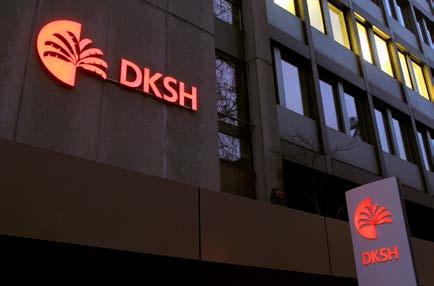
Sources:
• Defining alternative proteins
• Plant-Based Foods Rich in Protein
• 12 Amazing Health Benefits of Plant-Based Protein
• Future of plant-based meat
• Plant-Based Food Marketn
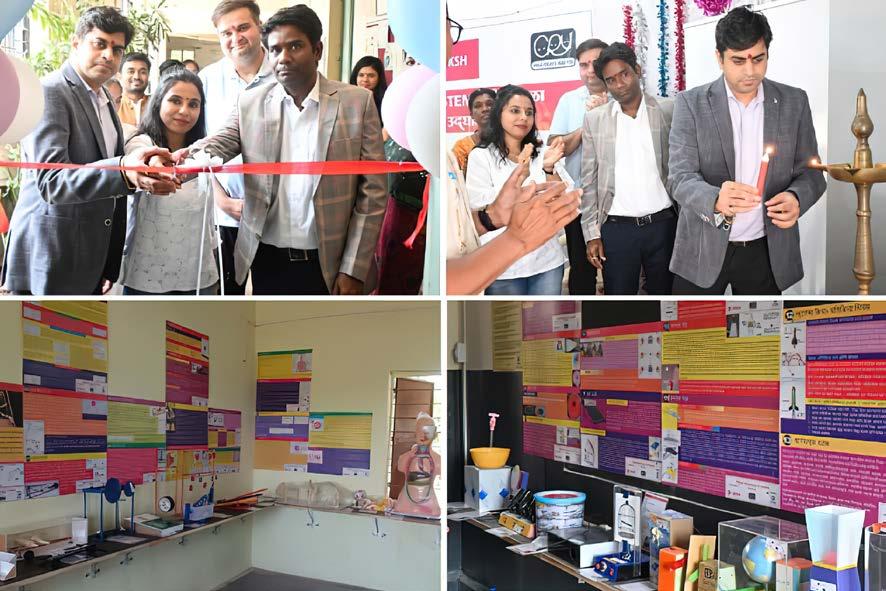



DKSH has partnered with CRY, an Indian non-governmental organization (NGO), to provide six community schools in the local regions of Pune and Wardha, Maharashtra in India with new labs for Science, Technology, engineering, and MaTheMaTicS (STeM) SubjecTS.
Mumbai, India, May 10, 2023 – DKSH

India has started a collaboration with CRY to ensure children get hands-on learning experiences through STEM labs. The partnership aims to develop the aptitude of children studying in grades six to nine toward science, eradicate the fear of learning, and set them up for a successful future.
The STEM lab project includes 80 models, 80 user placards, 40 colorful backgrounds, one safety placard, and one teacher’s manual to creating a platform for using the models along with an electrical connection.
DKSH partnered with CRY to provide STEM education to children as lifelong skills that will allow students to generate ideas, weigh decisions intelligently, and understand better how things relate.
Ms. Kreeanne Rabadi, DirectorWest, CRY, commented: “We are very grateful to DKSH for partnering with



us to bring STEM labs to government schools in Pune. The introduction to science, innovation, and technology in these labs offers marginalized children the opportunity for hands-on, experiential learning, expanding their horizons, and letting them explore their interests while acquiring crucial skills. Most importantly it motivates children to stay in school.”

Vishal Jawale, Managing Director, DKSH India, stated: “We are very pleased to have collaborated with CRY on this important project. Our STEM lab kits will help teach science and math to school children in a simpler way and give them the skills and knowledge they need to not only succeed on their educational path but also in life. This community project focused on improving life skills is in line with our overall sustainability strategy and the specific objective of making a positive local impact in the communities where we operate.”
CRY - Child Rights and You is an Indian non-governmental organization (NGO) that believes in every child’s right to a childhood - to live, learn, grow, and play. For over four decades, CRY and its 850 initiatives have worked with parents and communities to ensure lasting change in the lives of more than 3,000,000 underprivileged children, across 19 states in India. www.cry.
org



DKSH’s purpose is to enrich people’s lives. For more than 150 years, we have been delivering

growth for companies in Asia and beyond across our Business Units Healthcare, Consumer Goods, Performance Materials, and Technology. As a leading Market Expansion Services provider, we offer sourcing, market insights, marketing and sales, eCommerce, distribution, and logistics as well as after-sales services. DKSH is a participant of the United Nations Global Compact and adheres to its principles-based approach to responsible business. Listed on the SIX Swiss Exchange, DKSH operates in 37 markets with 32,600 specialists, generating net sales of CHF 11.3 billion in 2022.n





Prabhat Dairy is a part of the world's largest dairy organisation, Lactalis, which believes in taking the lead in making the world a better place. We aim to create a benchmark for a sustainable future that benefits our planet and society. This is a consistent, continuous and committed movement.



First and foremost, we recognise the importance of protecting the environment. That's why we have set ambitious goals to reduce our carbon footprint. By 2025, we aim to reduce CO2 emissions by 25%.
Furthermore, we are committed to reducing CO2 emissions by 50% by 2033 as we strive to become Carbon Net Zero by 2050.












Secondly, sustainability to us means leveraging innovative packaging technology to enable recycling and responsible resource management. We are dedicated to continuous improvement in recycling our product packaging, reducing environmental impact in the process. Furthermore, we are deeply committed to water conservation and recycling, which is why we have established a state-ofthe-art water treatment plant at our facility. Concurrently we are also setting up biogas plants so that the cattle dung can be used to power

homes in villages. We aim to install 10,000 biogas plants by 2025.

Another crucial aspect of our sustainability movement is promoting animal welfare. We firmly believe that the well-being of our cattle is of utmost importance. We have undertaken extensive training programs for our dairy technicians, emphasising the importance of providing our animals with a healthy and nurturing environment. Through continuous monitoring and adherence to strict guidelines, we ensure that our farms prioritise the welfare of our cattle. We also remain vigilant in identifying and
eliminating problematic practices that may compromise their wellbeing.





We understand that sustainability is a journey, and we remain committed to continuously improving our practices, setting new standards in the dairy industry, and going beyond the regulatory requirements as we are driven by a genuine desire to impact the world positively.
We invite everyone to join us on this journey and create an enriching legacy for future generations. Let us unite and work towards a better, more sustainable world.n

Smart packaging uses proprietary barcode, QR code or RFID technology to instantly track the exact location of a product within the supply chain for transparency. These features enable future planning and more efficient inventory management.
Food will generate the greatest demand for smart packaging, followed by healthcare and beverages. Smart food packaging helps businesses reduce food waste.
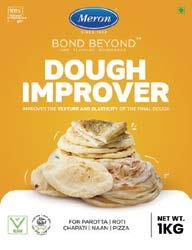
The food, beverage and healthcare industries are now increasingly using innovative packaging solutions. The global smart packaging market size was $22,257.6 million in 2020 and is expected to reach $38,662 million by 2030, growing at a CAGR of 5.5% from 2021 to 2030.
Smart packaging is a kind of machine that improves the efficiency and performance of the engine. Smart packaging is a packaging system that utilises sensor technology for various products such as pharmaceuticals and food. Smart packaging systems help improve product quality, extend shelf life, monitor freshness, and improve customer and product safety. These intelligent systems provide information on the quality and freshness of products packaged by intelligent packaging systems.
However, the cost of sensors and radio frequency identification (RFID) used in packaging applications makes better packaging more expensive than standard packaging, leading to failure of mass packaging systems. It also leads to the collection of customer data, which the manufacturers say could lead to manipulative and contradictory situations that limit the market in the future.
Additionally, the construction, manufacturing, hotel and tourism industries have been particularly affected by the Covid-19 outbreak. Production activity has been suspended or restricted. Construction and transportation activities and their supply chains are disrupted around the world. This has reduced smart packaging manufacturing and market demand, leading to a slowdown in
smart packaging market growth. On the contrary, the industry gradually resumed normal production and service operations.

This has allowed smart packaging companies to regain full production capacity and contribute to the market recovery in the second half of 2021.
Active packaging : Active packaging utilises a variety of advanced materials to provide features such as thermochromism, temperature, humidity and even microbial control. This helps improve the shelf life of the product and the quality of the contents during storage.
Intelligent Packaging: Intelligent packaging offers an additional benefit that goes beyond mere packaging, which is communication. It involves indicators and sensors placed inside or outside the packaging that diagnose product conditions, providing information about its status. This would include temperature, storage time, tightness, and freshness, among others.
One example would include that food packaging may change colour to indicate an interruption in the cold chain, salmonella contamination, or leaky packaging. Intelligent packaging offers an additional benefit beyond just packaging: communication. These are indicators and sensors placed inside or outside the packaging that diagnose the condition of the product and provide information about its condition. These include temperature, storage time, airtightness and freshness. An example is a food package changing colour to indicate a cold chain break, salmonella contamination, or a leaking package.
Design-led packaging: Design-led packaging is a type of packaging design that enriches the function and form of a product, supports its value perception,and enhances the user experience.
Connected packaging: This will enable brands to engage with
consumers through packaging that integrates technologies such as tags, QR codes, and sensors that can generate and collect data from third parties to better understand consumer behaviour, thereby enabling campaigns can be optimised. Connected packaging enables brands to add real value to their users ‘lives by turning packaging into an interactive brand tool, creating meaningful and long-lasting experiences for users.
In the smart packaging market, AsiaPacific will hold a dominant position in 2020, with LAME A projected to register the highest growth during the forecast period. The food and beverage segment is dominant and has the largest market revenue share.

Based on end-users, the smart packaging market is segmented into food and beverage, healthcare, automotive, personal care, and others. The food and beverage segment dominated with the largest market revenue share of 34% in 2022 and is expected to continue to do so during the forecast period. Smart food and beverage packaging helps monitor the condition of packaged food and the food environment. Due to lifestyle changes and people’s increasing interest in food safety, the need for smart packaging in food packaging is increasing.
Asia-Pacific is gaining ground due to increased consumption of freshly packaged groceries and the emergence of online shopping channels. Asia-Pacific dominated the market, reaching the largest market share at 33% in 2022. Market growth in the Asia-Pacific region is driven by increasing demand from manufacturing industries in emerging markets such as China, Japan, and India.
Growing demand for ready-to-eat meals and increasing consumption of dairy products in the Asia-Pacific region are driving the growth of the global market. Increasing trend of consumption of freshly packaged food is also driving the market growth.




The prevalence of smartphones and the emergence of online shopping channels have increased the
demand for smart packaging in the e-commerce industry.
In terms of market value for protective packaging, Asia-Pacific and North America will be the largest markets going forward, owing to increasing demand from the e-commerce sector for protecting shipped goods. Growth will be driven by increased consumer spending, technological advancements and improved manufacturing activities in the AsiaPacific region. Due to the presence of highly populated economies like India and China, e-commerce is expected to grow. Some 39.1% of global sales in 2021 occurred in the Asia-Pacific region. North America is expected to grow by 5.9% from 2023 to 2032. Growth in North America will be influenced by several factors, including urbanisation and a growing middle class.
As for biodegradable packaging, Asia-Pacific leads the market and is expected to hold the largest share during the forecast period. Increased population density is also one of the factors that made it convenient as a food and drink. In addition, developing countries such as India, China, Japan, and South Korea are expected to increase biodegradable packaging due to increasing industrial approaches and increasing population in regional markets, which will lead to demand for packaging materials.
Key Market Drivers
• The changing lifestyle of customers
• Exploration of nanotechnology
• The developments in the printing processes









Key Market Challenges
• Cost of capital
• The lack of awareness


• Incorporating expensive technologies
Key Market Opportunities
• Intelligent packaging in healthcare industry
• Lucrative market
• Demand for temperature controlled packaging solutions







A.Saranya (The author is assistant professor, Department of Nutrition and Dietetics, KSR College of Arts and Science for Women, Tiruchengode, Namakkal. She can be reached atasaranya105@gmail.com)

A.Saranya (The author is assistant professor, Department of Nutrition and Dietetics, KSR College of Arts and Science for Women, Tiruchengode, Namakkal. She can be reached atasaranya105@gmail.com)

Smart packaging uses proprietary barcode, QR code or RFID technology to instantly track the exact location of a product within the supply chain for transparency. These features enable future planning and more efficient inventory management.
Food will generate the greatest demand for smart packaging, followed by healthcare and beverages. Smart food packaging helps businesses reduce food waste.
The food, beverage and healthcare industries are now increasingly using innovative packaging solutions. The global smart packaging market size was $22,257.6 million in 2020 and is expected to reach $38,662 million by 2030, growing at a CAGR of 5.5% from 2021 to 2030.
Smart packaging is a kind of machine that improves the efficiency and performance of the engine. Smart packaging is a packaging system that utilises sensor technology for various products such as pharmaceuticals and food. Smart packaging systems help improve product quality, extend shelf life, monitor freshness, and improve customer and product safety. These intelligent systems provide information on the quality and freshness of products packaged by intelligent packaging systems.
However, the cost of sensors and radio frequency identification (RFID) used in packaging applications makes better packaging more expensive than standard packaging, leading to failure of mass packaging systems. It also leads to the collection of customer data, which the manufacturers say could lead to manipulative and contradictory situations that limit the market in the future.
Additionally, the construction, manufacturing, hotel and tourism industries have been particularly affected by the Covid-19 outbreak. Production activity has been suspended or restricted. Construction and transportation activities and their supply chains are disrupted around the world. This has reduced smart packaging manufacturing and market demand, leading to a slowdown in
smart packaging market growth. On the contrary, the industry gradually resumed normal production and service operations.
This has allowed smart packaging companies to regain full production capacity and contribute to the market recovery in the second half of 2021.
Active packaging : Active packaging utilises a variety of advanced materials to provide features such as thermochromism, temperature, humidity and even microbial control. This helps improve the shelf life of the product and the quality of the contents during storage.
Intelligent Packaging: Intelligent packaging offers an additional benefit that goes beyond mere packaging, which is communication. It involves indicators and sensors placed inside or outside the packaging that diagnose product conditions, providing information about its status. This would include temperature, storage time, tightness, and freshness, among others.
One example would include that food packaging may change colour to indicate an interruption in the cold chain, salmonella contamination, or leaky packaging. Intelligent packaging offers an additional benefit beyond just packaging: communication. These are indicators and sensors placed inside or outside the packaging that diagnose the condition of the product and provide information about its condition. These include temperature, storage time, airtightness and freshness. An example is a food package changing colour to indicate a cold chain break, salmonella contamination, or a leaking package.
Design-led packaging: Design-led packaging is a type of packaging design that enriches the function and form of a product, supports its value perception,and enhances the user experience.
Connected packaging: This will enable brands to engage with
consumers through packaging that integrates technologies such as tags, QR codes, and sensors that can generate and collect data from third parties to better understand consumer behaviour, thereby enabling campaigns can be optimised. Connected packaging enables brands to add real value to their users ‘lives by turning packaging into an interactive brand tool, creating meaningful and long-lasting experiences for users.
In the smart packaging market, AsiaPacific will hold a dominant position in 2020, with LAME A projected to register the highest growth during the forecast period. The food and beverage segment is dominant and has the largest market revenue share.
Based on end-users, the smart packaging market is segmented into food and beverage, healthcare, automotive, personal care, and others. The food and beverage segment dominated with the largest market revenue share of 34% in 2022 and is expected to continue to do so during the forecast period. Smart food and beverage packaging helps monitor the condition of packaged food and the food environment. Due to lifestyle changes and people’s increasing interest in food safety, the need for smart packaging in food packaging is increasing.
Asia-Pacific is gaining ground due to increased consumption of freshly packaged groceries and the emergence of online shopping channels. Asia-Pacific dominated the market, reaching the largest market share at 33% in 2022. Market growth in the Asia-Pacific region is driven by increasing demand from manufacturing industries in emerging markets such as China, Japan, and India.
Growing demand for ready-to-eat meals and increasing consumption of dairy products in the Asia-Pacific region are driving the growth of the global market. Increasing trend of consumption of freshly packaged food is also driving the market growth. The prevalence of smartphones and the emergence of online shopping channels have increased the

demand for smart packaging in the e-commerce industry.
In terms of market value for protective packaging, Asia-Pacific and North America will be the largest markets going forward, owing to increasing demand from the e-commerce sector for protecting shipped goods. Growth will be driven by increased consumer spending, technological advancements and improved manufacturing activities in the AsiaPacific region. Due to the presence of highly populated economies like India and China, e-commerce is expected to grow. Some 39.1% of global sales in 2021 occurred in the Asia-Pacific region. North America is expected to grow by 5.9% from 2023 to 2032. Growth in North America will be influenced by several factors, including urbanisation and a growing middle class.
As for biodegradable packaging, Asia-Pacific leads the market and is expected to hold the largest share during the forecast period. Increased population density is also one of the factors that made it convenient as a food and drink. In addition, developing countries such as India, China, Japan, and South Korea are expected to increase biodegradable packaging due to increasing industrial approaches and increasing population in regional markets, which will lead to demand for packaging materials.
• The changing lifestyle of customers

• Exploration of nanotechnology
• The developments in the printing processes
• Cost of capital
• The lack of awareness
• Incorporating expensive technologies
• Intelligent packaging in healthcare industry
• Lucrative market
• Demand for temperature controlled packaging solutions



XLR8 Sports Nutrition, a brand committed to providing high-quality sports and fitness nutrition, is pleased to announce a partnership with Umran Malik, India’s pace bowling sensation. The team at XLR8 is thrilled to welcome Umran and we believe that his unwavering dedication to his craft and his unyielding determination to succeed embodies the essence of our brand. His record-breaking ability to bowl fast resonates with our brand mantra to Never Slow Down!
At XLR8 Sports Nutrition, we are committed to providing






























athletes, fitness enthusiasts, and individuals with an active lifestyle with the highest quality nutrition they deserve. We understand that obtaining optimal performance and results is a combination of extreme effort, dedication and the right nutrition. We control all the critical aspects of the supply chain including stringent raw material sourcing specifications, our own state-of-theart FSSAI-approved manufacturing facility, and rigorous batch testing from an independent lab accredited by NABL.
Our brand tagline, "Never Slow Down", is a testament to our commitment to acceleration, perseverance, and the unwavering pursuit of excellence. We believe that success in sports and fitness requires a mindset of "never give up". By signing Umran Malik, the fastest bowler in the Indian cricket team, we hope to inspire a new generation of athletes and fitness enthusiasts to strive for excellence and never slow down. We are continuously innovating and expanding our product line to meet the evolving needs of our consumers. With our
commitment to quality, safety, and innovation, I am confident that XLR8 Sports Nutrition will continue to be a leading brand in the sports and fitness nutrition industry.

I thank our valued customers for their unwavering support and faith in our brand. We are dedicated to providing high-quality nutrition and assisting our consumers in reaching their fitness goals. Together, let's continue to push ourselves to new heights, "Never Slow Down". n














Diksha Shetty (The author is food consultant, F2F Corporate Consultants Private Limited. She can be reached at project@ farmtoforkindia.com)
Asia is rich and diverse, with each country having its own unique traditions and delicacies. Many Asian countries have a long-standing tradition of producing and enjoying sweets and treats made from local ingredients. For example, countries like India, China, and Japan have a rich history of producing traditional sweets and candies that date back centuries.
The confectionery segment in Asia is currently experiencing significant growth and evolution. Some key aspects of its current state include:
1. Market Size and Demand: The confectionery market in is substantial, driven by factors such as a large population, rising disposable incomes, and changing consumer preferences. Asia is one of the largest consumers of confectionery products globally, with a growing demand for both local and international brands.
2. Product Diversity: The Asian confectionery market offers a wide range of products, including chocolates, candies, gums, biscuits, and snack bars. The market is characterised by a mix of local and international brands, with a growing emphasis on premium and innovative offerings.
3. Health and Wellness Focus: Similar to global trends, the confectionery market is witnessing a shift towards healthier and better-foryou options. Consumers are increasingly seeking confectionery products with natural ingredients, reduced sugar content, and functional benefits.
4. E-Commerce and Retail Channels: E-commerce has emerged as a significant distribution channel for confectionery products in Asia, offering convenience, wider product choices, and attractive
promotions. Traditional retail channels, including supermarkets, hypermarkets, convenience stores, and specialty confectionery stores, also play a vital role in the market.
Here are some renowned confectionery products in Asia:
• White Rabbit (China): White Rabbit is a creamy and chewy milk candy that originated in China. It is known for its distinctive white, rice paperlike wrapping and its creamy flavour. White Rabbit candy has a nostalgic appeal and is often associated with childhood memories for many people in Asia.
• Pocky (Japan): Pocky is a beloved snack from Japan that consists of thin biscuit sticks coated with various flavours of chocolate or other coatings. It comes in a variety of flavours, including classic chocolate, strawberry, matcha, and cookies and cream. Pocky is known for its slender shape and is often enjoyed as a fun and shareable treat.
• Haw Flakes (China): Haw Flakes are a traditional Chinese candy made from the fruit of the Chinese hawthorn. These small, disc-shaped candies have a sweet and tangy flavour. Haw Flakes are often enjoyed as a nostalgic treat and are
known for their unique taste and texture.
• Kaju Katli: Kaju Katli, also known as Kaju Barfi, is a famous Indian sweet made with ground cashews, sugar, and ghee (clarified butter). It has a smooth and melt-inyour-mouth texture and is often garnished with edible silver foil. Kaju Katli is a soughtafter sweet for celebrations and special occasions.
Throughout the years, traditional processing methods have been passed down from generation to generation, while modern advancements have brought innovation and efficiency to the industry. Today, the confectionery processing landscape is characterised by a combination of heritage techniques and modern technologies.
In terms of current trends, there is a growing emphasis on product quality, flavour innovation, and customisation. Confectionery manufacturers are investing in stateof-the-art processing equipment and technologies to enhance efficiency, consistency, and safety. One notable advancement is the increased adoption of automated processing systems. Confectionery manufacturers in Asia are leveraging automation technologies such as robotic arms, conveyors, and computerised control systems
to streamline production processes. These automated systems offer benefits such as precise ingredient measurement, consistent mixing and blending, and accurate product forming and shaping. They not only improve production efficiency but also ensure product uniformity and reduce human error.


Another key advancement is the integration of digital technologies and smart manufacturing. Confectionery processing facilities are implementing data-driven systems and connectivity solutions to optimise production processes and enhance overall performance. Real-time monitoring and control systems allow manufacturers to track key parameters such as temperature, humidity, and production rates, enabling timely adjustments and minimising waste. Additionally, data analytics and artificial intelligence (AI) are being utilised to analyse production data, optimise recipes, and improve quality control. Manufacturers are investing in high-capacity mixers, continuous cooking systems, and precision-controlled depositors that offer increased efficiency, consistency, and flexibility. These advanced machines can handle larger production volumes while maintaining product quality and meeting the demands for customisation.
Moreover, there has been a focus on the development of ecofriendly processing solutions. Confectionery manufacturers are adopting sustainable practices by implementing energy-efficient equipment, reducing water usage, and optimising resource utilisation. Furthermore, the introduction of eco-friendly packaging materials and solutions is becoming increasingly common to address environmental concerns.
Overall, the current advancements in the processing of confectionery in Asia encompass automation, digitalisation, smart manufacturing,
and sustainable practices. These advancements not only improve efficiency and product quality but also enable manufacturers to respond to evolving consumer demands and market trends. The confectionery industry continues to embrace technological innovations to stay competitive and deliver high-quality confectionery products to consumers.
The packaging of confectionery has evolved significantly over time, reflecting changes in consumer preferences, technological advancements, and sustainability considerations. Historically, traditional packaging methods involved materials such as leaves, bamboo, and cloth, which provided a natural and eco-friendly way to protect confectionery products. However, with industrialisation and globalisation, modern packaging materials and techniques have gained prominence.
In the present day, the packaging of confectionery is influenced by several current trends. Firstly, there is a growing emphasis on attractive and eye-catching designs that enhance product visibility and appeal. Packaging is seen as a crucial marketing tool to differentiate brands and engage consumers in crowded retail environments. Bold colours, intricate patterns, and unique shapes are used to create visually appealing packaging that stands out on store shelves.
Packaging that enhances convenience, portion control,
and product freshness is gaining popularity. For example, re-sealable packaging allows consumers to consume confectionery products at their own pace while keeping them fresh for longer. Portion-controlled packaging, such as individually wrapped chocolates or candies, caters to on-the-go consumption and portion management.
Additionally, the integration of smart packaging technologies is likely to become more prevalent. These technologies can provide real-time information to consumers, such as product origin, ingredients, allergen information, and interactive content through QR codes or augmented reality (AR) experiences. Smart packaging can enhance consumer engagement and provide a more interactive and personalised experience.
To address concerns related to product authenticity and supply chain transparency, track and trace systems are being integrated into
confectionery packaging in Asia. Unique identifiers, such as QR codes or RFID tags, are used to track the product's journey from manufacturing to retail shelves.
Consumers can verify the product's origin and authenticity by scanning the code, building trust and reinforcing brand credibility.
The adoption of smart packaging in Asia's confectionery industry is driven by the desire to provide value-added experiences, enhance product safety, and differentiate brands in a competitive market. With the increasing use of smartphones and digital technologies, smart packaging is expected to continue evolving and becoming more prevalent across the region, offering a range of interactive and informative features to consumers.
The packaging of confectionery in Asia has a rich history that has transitioned from traditional materials to modern, eye-catching designs. Current trends focus on attractive packaging, sustainable materials, and functional features. Looking ahead, sustainability, smart packaging, and personalised experiences are expected to shape the future of confectionery packaging in Asia, meeting the evolving demands of environmentally conscious consumers and leveraging technology to enhance consumer engagement.
Conclusion
In conclusion, the processing and packaging solutions for the
confectionery market in Asia have witnessed significant advancements and transformations. Historical traditions and techniques have merged with modern technologies to create a dynamic industry that caters to diverse consumer demands.
The adoption of automation, digitalisation, and smart manufacturing has improved efficiency, consistency, and quality control in confectionery processing. Moreover, there is a growing emphasis on sustainable practices, with manufacturers embracing ecofriendly packaging materials and reducing waste.
Current trends such as flavour innovation, health-conscious options, and attractive packaging designs reflect the evolving preferences of Asian consumers. Looking ahead, the future of processing and packaging in the confectionery market in Asia will continue to be shaped by innovations in technology, sustainability, and consumer engagement.
Further advancements in automation, digital technologies, and smart packaging, manufacturers will be able to meet the changing needs of consumers while ensuring product safety, quality, and environmental responsibility. The confectionery industry in Asia is poised for continued growth and evolution, offering delightful and sustainable treats to consumers throughout the region. n




FOV is India’s pioneer in food consultancy and agricultural advisory services for more than 26 years. We draw on deep industry expertise to provide end-to-end consultation to food processing companies of all scales. Our Engineering team and Food technologists use skills to redesign food plants, processes, and machinery. Our in-house solutions include cutting-edge equipment and labs with capabilities in material handling, scanning, time & motion studies, and utility auditing to help increase clients’ production & output efficiency.
Our Agro-experts provide solutions for Farm produce procurement, Largescale farm management, and New product development. This is done via deep-rooted partnerships, agronomy & farm technology competence, as well as product sourcing & processing experience.
Our Re-engineering division uses solutions such as Scan-to-BIM to expand, maintain or amend projects, adding efficiency and cutting input costs. Through its impact on leading food brands and startups, FOV has changed the food industry’s dynamics in India.
In Agro based and food processing industry, FOV has in-house teams covering every area and aspect like
• Architectural planning
• Structural Designing
• Process engineering requirements
• Utility Designing (such as fire, ETP, HVAC, water solutions )
• Based on process engineering and utility designing we plan man material movement
• Define product quality and based on that selection of process and engineering
• Packaging equipment selection


• Utility selection
• Integration of process and utility services
• Define scope of mechanization and automation
B. Factory Layout
• Assessment of area requirement
• Horizon and adaptability for long term development
• Optimization of man, material movement
• Food safety and utility integration
• Vastu compliant design options
• Technology requirement
• Standard design to explain equipment as per market goal
• Inter-linking of utility, energy, water and waste optimization
• Automation
• Production demand
• Systems and process enhancement
• Process controls
• Process flows
• Quality assurance
• Safety standards
• Virtual construction ( Architecture / structure / Interior )
• Clash detection and constructability analysis
• Design, development and documentation
• Quantity estimation if required
OUR SPECIALITY FOODS
• Traditional Indian Snacks




• Western Snacks
• Ready To Eat / Cook
• Indian Sweets
• Frozen
• Dehydrated
• Vacuum Freeze
• Pulps And Purees
• Select Bakery Productsn
Scan to BIM (Building Information Modeling) is a process that uses 3D laser scanning technology to create a digital representation of an existing building or structure. These models depict the as-built condition of the building or site. They can be used for a variety of purposes such as planning repairs, maintenance, and improved design, as well as identifying problems early on. Facility management is another key area as these models can help organize facilities and utilities more effectively, leaving room for future changes.
The process begins with surveying and scanning the site to gather
in real-time using point cloud data for delivering as-built BIM models. Multiple scans are taken for refining and stitching the model for data to be optimized to high accuracy level. Modelling of scans is followed by scheduling, which elaborates on materials and timeline for construction. The next step is conflict resolution where problems can be foreseen and corrected. The last step is producing accurate shop drawings.

There are numerous advantages of BIM modeling in the construction of food processing plants. Some of these advantages include:
Increased accuracy: BIM ensures the correct specifications by capturing the exact dimensions and features of the plant down to 1 to 1.5mm.
Reduced time and cost: BIM reduces the time and cost of designing and building a food processing plant by capturing a large amount of data in a short period of time.
This can help to speed up the design process and reduce the need for manual measurements and drawings.It can also help with quantity estimation.
For example, BIM models can be used to calculate the amount of materials needed to build a food processing plant. This can help to reduce waste and save
Improved communication: BIM can help to improve communication and collaboration between different stakeholders in a food processing plant project, such as architects, engineers,
contractors, and owners.
Enhanced safety: BIM can be used to create 3D models of hazardous areas in a food processing plant. This information can be used to improve safety by identifying potential hazards and developing mitigation strategies.

Quality management: BIM models can help control projects and help in management activities by providing accurate information.
Enhanced compliance: BIM can be used to create 3D models of food processing plants that comply with regulatory requirements. This information can be used to ensure that the plant is operating in a safe and compliant manner.
Improved design and development: BIM can create models that can be used to simulate different design and operational scenarios. This can help to identify potential problems and improve the design of the plant before it is built.

Improved documentation: BIM models can be used to create comprehensive and accurate documentation of food processing plants. This documentation can be used to help with maintenance, repair, and upgrades of the plant.n
Contact Us: Fresh-O-Veg Pvt. Ltd. 11 Ravi Nagar, Khajrana Road, Indore, Madhya Pradesh, India. 452018 Telefax: +91 731 4006060
Email: rudra.pratap@freshoveg.com / vineeta.singh@freshoveg.com
Website: https://freshoveg.com/ Linkedin: https://www.linkedin.com/company/31045540/ Facebook: https://www.facebook.com/freshovegindia/ Twitter: https://twitter.com/FreshOVeg


Setup in 1916, by the illustr ious Shr i. Ghasit aram ji, the company has transcended borders and est ablished its foothold in the Indian food arena as a name to reckon with. Brought to India by his son late Shr i Goverdhandas ji and then car r ied for ward today by his g randson, Shr i Vippan Bajaj & his g reat g randson Shr i Kunal Bajaj.


Today we are one of the leading manufacturers & suppliers of authentic Traditional Indian sweets, super ior namkeen products, high quality dr y fr uits and salted snacks. Our products are being manufactured under most hygienic conditions using selected raw mater ials, super ior quality ing redients & pure ghee. Our list of esteemed clients is a long drawn one which includes Five St ar Hotels, Rest aurants, Flight Kitchens, Industr ial Canteens, Expor t Houses and a host of Caterers, Sub Contractors, in and around Mumbai and all over the World.
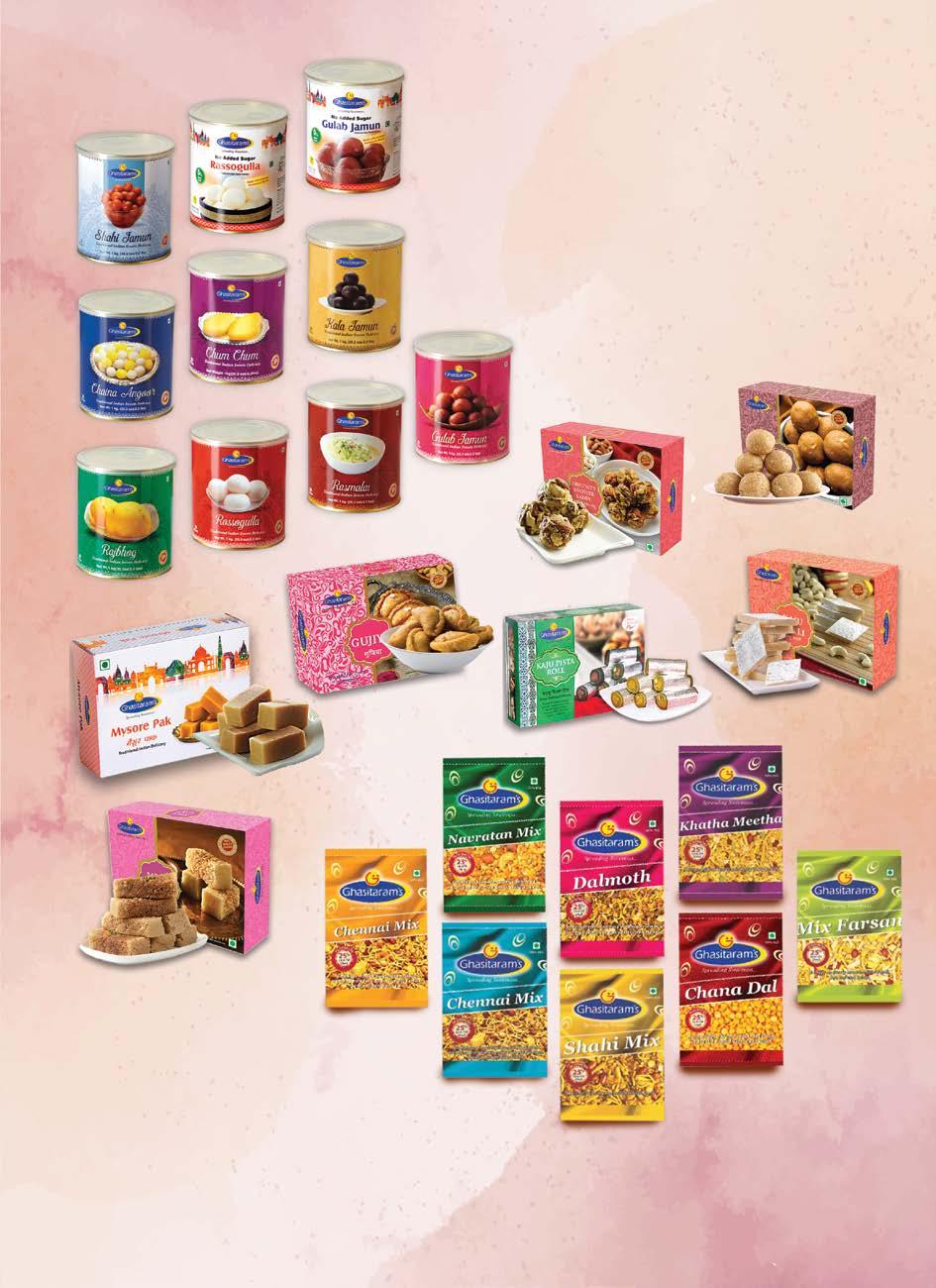


Our vision is to make Ghasit aram’s one of the most tr usted and prefer red Indian food brand in the local and global markets, adher ing to and satisfying our loyal customers. To manufacture the best quality and t asty products.

Our mission is to make the world t aste & exper ience our r ich Indian her itage through our food delicacies in their tr ue authentic for m, that br ings joy and happiness to the palates of consumers all over world. And to suppor t India’s g rowth in the inter national markets as a world player in the food industr y We want to be spreading sweetness all around. We are looking to expand nationwide and internationally looking for distributors and Franchisee


Food ingredients are substances added to food products to improve taste, texture and appearance and achieve specific technical or functional goals during production, storage or packaging. Food ingredients improve safety and freshness while still maintaining the nutritive value of food.
The food and beverages industry in China is a vast and rapidly growing sector that plays a crucial role in the country’s economy. China has a rich culinary tradition and a large population with diverse tastes, which has contributed to the development of a thriving food and beverage market. China’s food and beverage industry encompasses a wide range of businesses, including restaurants, fast food chains, cafes, bars, food processing companies, and beverage manufacturers.
With the growth of the middle class and urbanisation, Chinese consumers have become more discerning and health-conscious. There is an increasing demand for higher quality and safer food products. Organic, natural, and healthy food options have gained popularity, as have international cuisines and flavours.

Convenience and ready-to-eat meals are also in high demand due to busy lifestyles.
With around 1.4 billion consumers, coupled with increasing demand for quicker and safer food, China’s thriving food industry shows no signs of slowing down. The government has implemented stricter regulations and inspections to address food safety concerns. Consumers are increasingly seeking products with traceable origins and reliable certifications to ensure their safety.
China is one of the largest consumers and producers of food ingredients globally. The market includes various types of ingredients such as additives, flavours, sweeteners, preservatives, emulsifiers, colours, and functional ingredients used in food and beverage processing.
Factors driving the growth of the food ingredients market in
China include changing consumer preferences, increased demand for processed foods, expanding food and beverage manufacturing sector, and advancements in food technology. Additionally, the government’s focus on food safety and quality has led to stricter regulations and a greater emphasis on using highquality ingredients.
Local Chinese companies, as well as multinational ingredient suppliers, are active in the market, providing a wide range of products to meet the diverse needs of the food industry.
As per research reports, 73% of Chinese consumers are willing to pay more for health ingredients and supplements. China is the world’s fourth-largest retail market for organic food and beverages, which shows enormous potential for growth. Demand for international health supplements remains high – over 50% of surveyed Chinese consumers had purchased imported nutrition supplements.


The history of the food ingredients
ingredients into Chinese cuisine, enriching the repertoire of food ingredients available.
Continued from page no 34
to meet these stringent requirements.
industry in China is deeply intertwined with the country’s rich culinary traditions and cultural heritage. Over thousands of years, Chinese cuisine has evolved, incorporating a diverse array of ingredients and flavours. Ingredients like soybeans, rice, wheat, and tea have been staples of the Chinese diet for centuries. These foundational ingredients formed the basis for the early food industry, providing essential elements for cooking and flavouring dishes.
The imperial Chinese kitchens employed chefs and food scientists who experimented with different ingredients, seasonings, and cooking techniques. This led to the emergence of new ingredients and flavours that would shape Chinese cuisine.
Growth of international trade and cultural exchange expanded the food ingredients industry in China further. Foreign ingredients and culinary influences, such as spices, fruits, and vegetables, were introduced to China via the Silk Road and maritime trade routes. This exchange led to the integration of foreign flavours and
The establishment of the People’s Republic of China in 1949 led to a period of central planning and statecontrolled food production. During this time, the government invested in food research and development, leading to advancements in food processing, preservation, and ingredient production.The history of the food ingredients industry in China reflects a rich tapestry of culinary traditions, cultural influences, and technological advancements.
The sheer size of the Chinese market creates immense opportunities for food ingredient manufacturers and suppliers to cater to the diverse tastes and preferences of a large consumer base. China has a rich culinary heritage with a wide range of regional cuisines and flavours. This diversity extends to the ingredients used in Chinese cuisine, which vary significantly across different provinces and cities. The food ingredients industry in China benefits from this culinary diversity by supplying a broad range of ingredients that cater to the unique requirements of various regional cuisines.
Natural herbs and ingredients are used in traditional Chinese medicine. These have a strong influence on the food ingredients industry in China. Traditional ingredients, such as herbs, roots, and fungi, are utilised for their perceived medicinal properties and incorporated into food and beverage products.
Focus on rigorous regulations and standards, promoting greater scrutiny of food ingredients and their sourcing has deflected the attention towards manufacture and sale of ingredients that are safe and healthy. The industry has responded positively by investing in quality control measures and certifications
China has a thriving e-commerce ecosystem, with online platforms playing a crucial role in the food ingredients industry. E-commerce platforms provide easy access to a wide range of ingredients for both businesses and consumers. These unique aspects make the food ingredients industry in China a dynamic and exciting market, offering opportunities for innovation, collaboration, and meeting the evolving needs of Chinese consumers.
Chinese consumers are becoming more health-conscious and demanding higher quality, natural, and functional food products. There is a growing interest in clean label ingredients, plant-based alternatives,
organic ingredients, and products with specific health benefits. This trend is expected to drive the demand for innovative and healthier food ingredients. Increase in disposable incomes has resulted in higher spending on food and beverages, including premium and value-added products. The Chinese government has been actively promoting food safety and quality. Stricter regulations and standards are being implemented to ensure the safety and traceability of food ingredients. This creates opportunities for ingredient suppliers who can meet these stringent requirements and provide transparent and certified ingredients.
Advances in food processing, preservation techniques, and ingredient formulations are driving the demand for new and improved food ingredients. There is a growing focus on functional ingredients, such as probiotics, antioxidants, and
natural food colours, which offer health benefits and meet consumer preferences. Ingredient suppliers that prioritise sustainability and offer traceable and responsibly sourced ingredients are likely to gain a competitive edge.
China is an active player in international trade, both as an importer and exporter of food ingredients. The country has been expanding its global collaborations and partnerships in the food industry, which opens up opportunities for ingredient manufacturers and suppliers. International ingredient
suppliers can tap into the Chinese market, while Chinese companies can access a wider range of ingredients from global sources.
Today, the food ingredients industry in China is characterised by a wide range of products, including additives, flavours, sweeteners, and functional ingredients. Meeting evolving consumer preferences, complying with regulations, and embracing technological advancements will be crucial for ingredient suppliers to thrive in this dynamic market.n
Venkatesh Ganapathy (The author is associate professor [marketing] at Presidency Business School, Bengaluru)
o r






Highlights
• Aro nd e hibi ng companies from India & abroad










• , sq. meters of e hibi on area
• Li e demonstra on of machines
• Seminar on “S stainabilit thro gh technolog and inno a ons for the Indian Dair Ind str ” b Indian Dair Associa on (West Zone)




• Seminar on “Metal container packaging in food & be erages” b Metal Container Man fact rers’ Associa on (MCMA)







 Lithiyal R,
Lithiyal R,
In recent decades, Asian countries’ high economic growth rates, young and growing populations, industrialisation and open markets, increasing disposable income and urbanisation have all multiplied, fostering the meteoric rise of their industries. As a result, food processing and preservation techniques have greater demand among the population, as the hassle of day-to-day work needs more time to make wholesome food and beverages and for the prolonged utility of food to consume as fresh. This results from bringing out emerging technologies in the food processing and packaging market. The dried processed food market in the Asia-Pacific during 2022 was worth US$61.41 billion and is estimated to reach US$ 81.03 billion by 2028. Drying is a preservation technique, thereby increasing the shelf-life, having unique flavour & taste, and retaining the nutritional value of food items.
Asian countries are the top foodproducing countries in the world. China is first ranked in fruit and vegetable production, followed by India. India is the single-largest milk producer in the world, with similar stature in meat, poultry, and marine production; 90% of the rice production is from Asia. In this scenario, food processing and packaging industries play a crucial role in ensuring the availability of safe, nutritious, and convenient food products for consumers.
Processing and packaging technologies include conventional, novel methods for food processing and non-thermal methods for food production which emphasise environmental protection, and this article focuses on how far the Asian food processing and packaging industry is developed and explains the need for sustainability, environmental protection, novel methods in the food processing and packaging sector.
Chinese and Indians, along with cultivating rice, wheat, and millet they developed pickling, drying and fermentation techniques.The spice trade in India has a crucial effect on the Indian food industry. It was when industrialisation and modernisation in the early 19th century that the food industry boomed in both the Western world and the Asian continent. Initially, it was started to fulfil the need for food for growing populations, and now it is a form of globalisation, cultural exchange, and a multibillion industry. The Asian food industry has its impact on the Western world, the flavours, blending of Chinese and Indian flavours in Indo-Chinese cuisine or the incorporation of Japanese ingredients and techniques in Western cooking. Today, the food industry in Asia continues to evolve, adapting to changing consumer preferences, technological advancements, and sustainability concerns. Traditional culinary practices coexist with modern innovations, creating a vibrant and diverse food landscape across the continent.
Advancements in Processing and Packaging:
In the era of industrialisation and modernisation food industry has also boomed. The last three industrialisations focused on conventional techniques for processing, including drying, fermentation, freezing, canning, baking, and frying, along with automation, data analysis, high-speed filling machines, automated packaging systems, and some of the advanced food preservation techniques, supply chain management techniques are introduced and developed to the extent. Now the fourth industrial revolution, or Industry 4.0, is going on, which in terms of the food industry includes precision fermentation, blockchain technology, artificial intelligence, 3D printing, Internet of Things. The main aim of the Asian food sector is sustainability along with efficient production and to attain market supremacy.
Food packaging is essential for keeping food items fresh and ensuring they arrive at their destination without losing their original flavour or quality. In addition, it preserves the contents from contaminants and moisture, prevents spills and tampering, and helps food goods maintain their form and quality. The food packaging market in Asia-Pacific
nation like India, where the need for online meal ordering is rising, packed food boxes are becoming increasingly popular in the food packaging industry. In February 2022, one of the meal delivery services, Zomato, said that during the past five years, the monthly active food delivery restaurants and transactional clients had increased by an average of six and 13 times.
is categorised by Material Type (plastic, paperboard, glass, metal and laminates), Product Type (Bottles and Containers, Films and Wraps, Cans, Cartons & Pouches, Caps and Closures), End User type (Meat and Poultry, Fruits and Vegetables, Dairy Product and Confectionery) and Country (Japan, South Korea, China, India, Singapore, Indonesia, Thailand, Malaysia, Australia, New Zealand, the Philippines, and Rest of Asia-Pacific). According to Data Bridge Market Research analysis, from 2022 to 2029, the market is predicted to increase at a Compound Annual Growth Rate of 7.2%, from 2021’s US$2,377.40 million to 2029’s US$ 4,141.99 million. One of the major sectors in India, food processing accounted for 32% of the nation’s total food market and was rated fifth in terms of production, consumption, export, and anticipated growth.
The food packaging market is also driven by consumers’ increasing desire for processed foods due to the growing working population, increased disposable incomes, busy lifestyles, and population dynamics shifting from rural to urban regions. Additionally, in a
Flexible packaging of food items is now possible through the new technologies that have emerged, including active packaging, intelligent packaging, and engineering science. In addition, manufacturers have taken on biodegradable packaging that can be recycled, rejuvenated, and reused to create environmentally friendly packaging. Nextgeneration packaging trends would segment into susceptors, RFID tags, NFC tags, sensors & output devices, coding & markings, and others.
India’s pharmaceutical and food packaging industries are the main drivers of flexible packaging industry growth. Regular rigid packaging consumers have been switching to flexible packaging in recent years. Industry sources claim that flexible packaging’s attractive appearance, affordability, and durability are the leading causes. Consumer demand for easy packaging and reasonably sized laminated packages of packaged goods is one of the main factors behind the growth of flexible packaging in India.
According to the Flexible Packaging Industries Association, flexible packaging accounts for more than 60% of the market and is mainly used for food. The flexible packaging business is multiplying due to its ability to integrate innovative solutions for the numerous packaging problems it observed.
The Asian continent has the most populous nations, including India, China, and Indonesia, with rapid population growth and immense
natural resources. Efficiently utilising these both is challenging; the food sector directly connects these two entities. Therefore, the use of technologies that leads to sustainability needs to be adopted, such as waste reduction and management, responsible sourcing and fair trade, promoting plantbased and alternative proteins which cut down animal husbandry practices, which in turn reduces greenhouse emission, and use of nonthermal technologies or green technologies, Sustainable packaging, and towards sustainable food production precision fermentation is the promising technique which uses microbes to produce food components like proteins, carbohydrates from the waste matter or any other resources like all these technologies need to be developed to attain utmost sustainability.
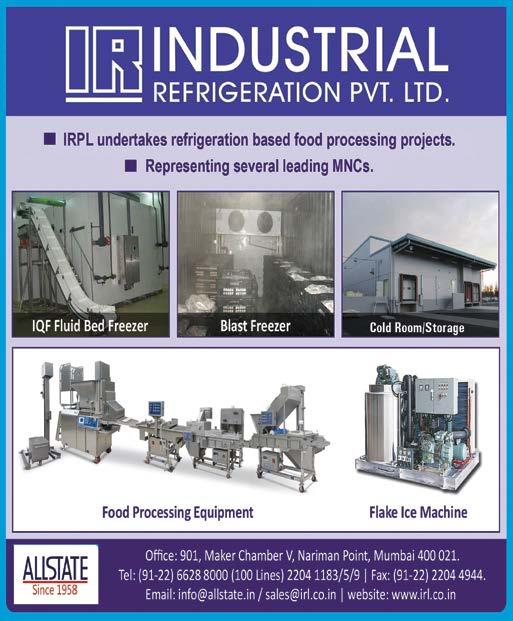
Overview:
A few of the major industries operating in the Asia-Pacific
packaging market are Bemis Company, Sealed Air Corporation, Ampacet Corporation, LCR Hallcrest Ltd., Mondi Group, Smurfit Kappa Group, WestRock Company, Tetra Pack, R.R. Donnelley & Sons Company, Sonoco Products Company, Smart Packaging, Amcor Plc, Constantia


Prof. Kajal Verma (The author is associate professor, Institute of Good Manufacturing Practices India [IGMPI], New Delhi)
Over the forecast period (2021–2026), the Asia-Pacific active and intelligent packaging market is anticipated to grow at a CAGR of 6.2%. The recent Covid-19 outbreak left the active and intelligent packaging producers with a plethora of problems, most of which are only anticipated to last for a short while. The lockdown had several negative repercussions, such as supply chain interruptions, a lack of raw materials for manufacture, workforce shortages, pricing fluctuations that could drive up production costs and push them over budget, and shipping issues.
Shrewd bundling is a blend of materials, science, and innovation that upgrades the bundling usefulness by executing dynamic and keen bundling in traditional bundling. It assists with forestalling food decay, upgrade food item credits like fragrance, taste, and flavour, and furthermore helps in brand assurance, premium evaluating, and squander decrease.
Rising utilisation of brilliant bundling to build the timeframe of realistic usability and detectability of food items is supposed to observe the positive effect on by and large industry development in the estimate period. In addition, the developing web based business market and rising industrialisation combined areas of strength for with for unrivalled strategies and production network the board are probably going to set out worthwhile open doors for players working in this market.
Utilising legal additives in packaging films or packaging containers allows for the maintenance and extension of product shelf life. This is known as active and intelligent packaging.
Active packaging plays a dynamic role in food preservation by allowing packages to communicate with food and the environment. The active and intelligent packaging market in Asia-Pacific is divided into types (Active Packaging, Intelligent Packaging), End-

and Countries.
Smart labels and tags, as well as time-temperature indicators, are gaining popularity. Many of these gadgets were once regarded as unnecessary or unaffordable, but technical breakthroughs that enable the production of printed electronics at low costs and the replacement of specialised electronic readers with smartphones may enable them to become widely used. The quick adoption of tracking-enabled or interactive packaging components will be pushed by recent laws in the food industries, which requires producers to make products safer and easier to recall.
Based on the area, the savvy bundling market is fragmented into North America, Europe, APAC, Latin America, and the Centre East and Africa. During the estimated time-frame, the Asia-Pacific market is supposed to develop at the most noteworthy CAGR. The evolving way of life, expanding interest in bundling arrangements with longer manageability, and developing interest in new and quality food are the elements driving the development of this local fragment.
The increase in the senior population, the number of chronic illnesses, and the need for over-thecounter medicines all contribute to the expansion of the food and healthcare sector. As food packaging regulations tighten, active packaging solutions are growing in popularity. Due to the

plastic materials are restricting issues in the RFID keen bundling business sector's development. The lack of integrators and complete item creators is another component.
A portion of the open doors in the RFID wise bundling market relate to propels in printing innovation, which can support the market.
the capability of unmistakable dynamic bundling to stand apart from the remainder of their opposition and increment productivity.

growing complexity of items that need to be stored or transported to remote areas while maintaining their integrity, the market for active packaging is anticipated to expand over the course of the anticipated period.
Because of industry maturity, demand growth for microwave susceptors, desiccants, and corrosion control packaging will be more moderate. However, healthy growth will continue to be observed as new goods are introduced to carry out these common functions more effectively. Desiccants are now included in pharmaceutical bottles or caps to offer moisture management, and new environmentally friendly corrosion control scavengers have been developed, for example.
The utilisation of shrewd bundling in the production network the executives of food merchandise forestall robbery and falsifying while likewise working on the picture of food firms regarding marking and promoting. By utilising RFID savvy and smart bundling in the online business and store network, clients can follow items at each phase of their excursion, including their area. A buyer can get more data by means of RFID marks and labels than from a normal name.
Exorbitant costs, restricted accessibility, and an absence of customer information on adaptable

The growth of the RFID Intelligent Packaging market is being constrained by factors including high costs, a lack of availability, and a lack of consumer awareness of flexible plastic materials. Another issue is the lack of full product designers and integrators. The market for RFID intelligent packaging offers some prospects related to improvements in printing technology.
Manufacturers can accomplish this goal by managing plant assets with RFID technology. For many sites in a manufacturing plant, such as conveyors, cameras, boilers, tanks, pipes, and so forth, a combination of RFID tags and sensor technologies is an appropriate solution to monitor and maintain the quality and output of a manufacturing process. RFID tags are used in the manufacturing sector to track moveable assets, including.
The expansion in fake items, particularly in the drug and individual consideration businesses in arising economies, additionally constrained organisations to utilise advancements, like RFID during bundling. This large number of elements represent a significant ascent in the interest for dynamic and canny bundling. In any case, the underlying capital required because of greater expenses of establishment and execution and security issues in regards to with these frameworks are testing the development of the market
The developing meaning of current bundling in the food business has driven the brands to use
A newness marker straightforwardly shows the nature of the item; it is normally as names on the compartment. Ripeness is the main keen sensor label that changes tones to show the readiness of organic products. It performs over-response to the smell released by the natural product as it ages; at first, it is red and afterward graduates to orange and lastly yellow, contingent upon the decision of the needed degree of advancement while eating the natural product. A new pattern like the rising utilisation of remote advances in blend with shrewd bundling in the food and refreshment industry to furnish buyers with constant states of the transient products is probably going to drive the business interest. Furthermore, the rising utilisation of brilliant bundling in the food industry by virtue of its better solidness, adaptability, and lightweight properties is probably going to fuel the market development.
Then again, recyclability issues with squander produced by shrewd bundling are retraining the brilliant bundling market. Even though administration arrangements for treating bundling waste and reusing have been set up for very any time, viable practice shows that reusing different bundling waste is muddled. One of the primary issues in the plan and creation of savvy bundling is to propel research on reusing bundling waste, for example, tracking down additional appropriate materials for executing sensors and bio-degradable functionalities. The food brands keep on advancing on the lookout, covering a large portion of the magnificence and individual consideration classifications. Food brands' cooperation in special missions, like limits and offers in fundamental scientists/ food stores, and online retailers, consistently, keep on animating buys.
The rising interest for cutting edge bundling arrangements from the food handling developing purchaser worry for food wastage decrease, and rising interest for shrewd and useful bundling are the main considerations driving the development of this market. Besides, the developing online business market and rising industrialisation combined areas of strength for with for prevalent strategies and production network the board are probably going to set out rewarding open doors for players working in this market. n
Back on popular demand, Magnolia Bakery is bringing back the highly anticipated Saffron Tres Leches this season!
A delectable variant of the Classic Tres Leches at Magnolia Bakery, this sweet treat gets a rich & decadent makeover. The
flavourful incorporation of saffron takes this all-time favourite dessert to new heights and transforms it into a mouth-watering treat. Order now and savour every blissful bite from the comfort of your home or visit the store to relish this scrumptious delight onsite. This special is hand-made and freshly made daily. n











Mondelez
International, Inc. has published its Fiscal Year 2022
Snacking Made Right Report, advancing progress against its Environmental, Social, and Governance (ESG) priorities and delivering on the company’s mission to lead the future of snacking.
The report is part of the company’s wider goal to provide transparent, measurable information to its stakeholders on its ESG goals, policies, initiatives and programmes, while seeking to amplify and accelerate the company’s sustainability vision of helping to create a future where together people and the planet thrive.
Last year, the company elevated sustainability as the fourth pillar of its long-term growth strategy.
This report illustrates Mondelez International’s achievements thus far in building a more sustainable snacking company that will help to enable innovation and accelerated long-term growth, grounded in the best interests of its stakeholders.


“As we continue confidently into our second decade as a responsible, highgrowth, pure-play global snacking company, we are prioritising key areas of Snacking Made Right so we can drive innovative, more sustainable growth the right way for people and the planet,” said Dirk Van de Put, chairman and CEO of Mondelez International. “I am proud that at Mondelez International we are making progress toward achieving our vision at a time of considerable change and challenges.
We are demonstrating our clear commitment to leading the future of snacking.”
This year’s Snacking Made Right report illustrates the company’s progress toward its 2025 goals, including sourcing more sustainable ingredients, helping reduce climate change, improving packaging, advancing diversity, equity and inclusion (DE&I) initiatives, and supporting customers, colleagues and communities.
In the past year, the company made considerable headway towards its 2025 goals, including:
Focusing on more sustainable sourcing of key ingredients, lowering climate impact, respecting human
rights and increasing packaging design for recyclability.
Building our pool of deep and diverse talent, making strong progress in our global DEI ambitions for colleagues, culture and communities.
Evolving our portfolio as we strive to meet a range of consumer nutrition and well-being choices, while promoting mindful portions and active lifestyles.
During 2022, Mondelez International continued leading in helping to make cocoa right through Cocoa Life - signature global cocoa sustainability programme, with over 230,000 farmers participating as of end of 2022. The company also announced the next phase of Cocoa Life, backed by an additional $600 million through 2030, for a total of $1 billion investment since the start of the programme, to increase its cocoa volume scale, aim to work with nearly 300,000 farmers by 2030, and accelerate its impact.

“At Mondelez International, we are wholeheartedly committed to going further and faster in terms of sustainable growth and impact,” said Christine Montenegro McGrath, senior vice president and chief global impact and sustainability officer at Mondelez International.
“Building on our 2025 public goals, we have bold and targeted longterm ambitions which help us focus, accelerate and scale our efforts, and we are also putting a longerterm focus on working toward our 2050 goals of net zero carbon and packaging waste by supporting circular economies.”n
Monkey Shoulder, the free-spirited blended malt owned by William Grant & Sons announced the sixth season of its most awaited 'Ultimate Bartender Championship' amongst the bartending community in India. The championship culminated its Mumbai city round on May 22 at Lord of the Drinks, Powai, with over 80 talented bartenders from the city mixing, moving and shaking to claim the mask!
Hosted and judged by Monkey Shoulder India’s brand ambassador and chief monkey officer Gaurav Sareen the event saw a gush of energy from a zealous group of bartenders paving their way through five exciting mixology challenges.

The top finalists from Mumbai, Vishal Tawde from PCO Mumbai,
Rudra Kumar from Blah, Jay Mhamunkar from Eve emerged with flying colours and will now compete with other city round finalists at the finale.
This year, the brand is set out to “Unmask the next champion” aka most passionate and skillful bartender across the country. The championship is structured to
evaluate "the skills that pay the bills.” The five distinct levels of the competition concentrate on essential skills like industry knowledge, pouring, nosing, table service and nailing the perfect serve.
Commenting on the championship, Kapila Sethi Kad, marketing head, said, "Monkey Shoulder is proud to support the bartending community
in India. The Ultimate Bartender Championship is a testament to the brand’s ethos of light-heartedness, cheeky creativity, and enthusiasm. The city round in Mumbai witnessed some of the best bartending talent in the country. This has further strengthened our commitment to grow trade in the city and help these bartenders thrive and reinvent themselves."
Speaking on the first two city-rounds of the 2023 season, Sareen said, "The Ultimate Bartender Championship is a hunt to unmask, untap and unleash the hidden talent amongst the bartending community.It provides a platform to the creative geniuses of alco-bev fraternity to help them grow and excel in this field. Mumbai city round saw a bunch of talented bartenders showcasing their skills and talents with utmost passion.”n
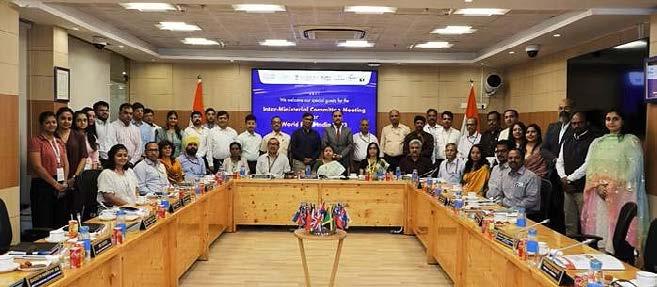
Anita Praveen, Secretary, Food Processing Industries, chaired the First Inter-Ministerial Committee Meeting with senior representatives from Ministries/ Departments/Boards here recently. The agenda of the committee meeting was to apprise the officials of preparation made so far for World Food India 2023 and discuss participation of respective Ministries/ Departments/Organisations in the event. This was in continuation to series of interactions held to apprise the Ministry’s plan of action for the upcoming World Food India 2023 and discuss potential areas of collaboration. The roundtable witnessed participation from the senior officials of key Central government ministries and departments.
During her address, Praveen requested the officials to share specific plan of action regarding their participation/ partnership in the Mega Food Event that is being organised from November 3-5, 2023, in New Delhi.
All Central ministries and departments

were requested to share suggestions on the planned sessions of World Food India and participate in the event actively as well as support the Ministry in awareness creation on the relevant department’s social media handles, embark participation of senior policy makers, industry members, SHGs and all relevant stakeholders to make the event a grand success.
Further, the participating officials assured support to Ministry of Food Processing Industries
(MoFPI) through technical/sectoral sessions, investment-oriented sessions with Ambassadors and High Commissioners, buyer seller meets/ RBSMs, engagements with startups/ IPRs/ONDC, promotion of Ayush
Aahar products and GI products.





Some of the suggestions / feedback given by the officials included ensuring participation from exporters associated with the respective boards.
Praveen concluded her remarks by urging all stakeholders to join hands in making the event a success by
leveraging their respective strengths and extending additional support.
The next meeting of the InterMinisterial Committee is expected to be held in June 2023 to firm up concrete partnership/participation of different stakeholders.
Further, the Investment Facilitation Cell (Invest India) and the event partner (FICCI) were directed to coordinate with the respective ministries and departments for facilitating the discussed action plan and seek necessary support from government bodies.n




























Oghma Partners has announced that it has acted as the exclusive financial advisor to the shareholders of UK-based specialist ingredient business, Good Food Wines Limited (GFW), on the sale of its business to Kiril Mischeff Limited (Kiril Mischeff), a leading UK food and ingredient importer and supplier to the food and beverage industry.
GFW is a leading supplier of alcohol, vinegars, and condiments to the food and beverage manufacturing industries in the UK. Its customer base comprises numerous “bluechip” manufacturers and reputable names in the food and beverage industry.


The acquisition of GFW will enable Kiril Mischeff to capitalise on significant revenue synergies, thanks to the complementary product portfolio of GFW. The current management team comprising Mike Yates and Stuart Medcalf will continue to lead the business and all current staff will remain at the firm following the acquisition. The business will continue to trade as Good Food Wines Limited.
Commenting on Oghma Partners’ role in the transaction, Mike Yates, shareholder and MD of GFW, said:
“We are grateful for Oghma’s expert advice and support throughout this process. It has been a pleasure working with the team from start to finish.”
Mark Lynch, partner at Oghma Partners, said: “It was a real joy to work with the GFW and Kiril Mischeff teams and to have reached a successful conclusion to the discussions. This is our third completed food & beverage transaction in 2023 and marks our 22nd deal in the food ingredients sub-sector in Europe which makes Oghma Partners the most active M&A advisors in this sub-sector of the food industry.’’
The announcement follows the recent sale of UK-based C.T. Holmes Limited to Brasmar Group SGPS, S.A, one of the main European players in the seafood industry; K.T.C. Edibles Limited, the UK’s largest suppliers of edible oils, to Endless LLP; Wrights Food Group on the sale of the business to the Compleat Food Group; Sykes Seafood Limited on the acquisition of Ruskim Seafoods Limited; Novax AB on its acquisition of Ulrick & Short Limited, the UK-based clean label food ingredients specialists; and Direct-to-Consumer and UKbased recipe provider, SimplyCook Limited’s sale to Nestlé.n
The Indian Channel, a new luxury fine dining destination offering a multi-cuisine culinary experience, is now open in Ahmedabad. After four years of successful catering events, the house of catering with a reputation for exceptional cuisine and unparalleled service, the owners Karan Dutta and Sujas Mini are excited to share their culinary journey in a luxurious way through The Indian Channel.
The Indian Channel features an elegant and sophisticated ambiance, perfect for those looking for a refined dining experience. The restaurant’s menu boasts an extensive range of culinary options, focusing on bringing the world’s finest flavours to your table. From exotic Indian spices to traditional Italian dishes, there is something for everyone.
The Indian Channel has established itself as a premier luxury fine dining destination, offering patrons an elegant and sophisticated culinary experience. The restaurant’s expert team of chefs, led by executive chef Aishwarya R. Mertiya, has curated a menu showcasing the best of international cuisine, emphasising

locally sourced ingredients. Each dish is crafted with precision and care, using only the freshest and highest quality ingredients. The menu is carefully curated to showcase the team’s expertise in classic and contemporary cooking techniques, featuring a selection of signature dishes. Some of the best-selling dishes include the delectable Sangri ke Shammi, Burrata -Tomato Jam, Sundried Tomato Risotto, Avocado Cream Cheese Roll, Bhareli Bhavnagri Mircha with lemon missi roti a perfect amalgamation of the Indian cuisines with Western Continental which quintessentially complements the richness of the restaurant.
Being the first fine dining restaurant in Gujarat, The Indian Channel offers an unparalleled luxurious dining experience with a multicuisine menu in a very Indian way. The Indian Channel can accommodate up to 255 guests in its spacious dining room, making it an ideal venue for large parties, corporate events, and special occasions. So, whether you’re celebrating a special memory or simply looking for an exquisite meal, it is the perfect destination for a truly unforgettable experience.n

Chhatrapati Shivaji Maharaj International Airport (CSMIA) has announced the launch of IKAI Maharashtra - a premium, luxury mithai and namkeen brand that celebrates the unique flavours authentic to Maharashtra. The core of IKAI Maharashtra lies around a commitment to crafting original and innovative sweet and savoury offerings that showcase the best ingredients the state has to offer.

IKAI Maharashtra was brought into existence to cater to the passengers travelling out of Mumbai, and travellers looking to carry all the mouth-watering delicacies from Maharashtra. The cuisine has an inexhaustible variety of flavours and dishes that are state-specific. And with the launch of IKAI Maharashtra, CSMIA has made it possible for travellers flying out of Mumbai to not only savour but also carry along the delectable specialities from Maharashtra all available under one roof.
CSMIA is committed to promote regional cuisine and provide travellers with a taste of the local food culture of Maharashtra. IKAI Maharashtra store located exclusively at Terminal 2, offers a variety of snacks, sweets and everything authentic to the state of Maharashtra. IKAI Maharashtra takes pride in using locally sourced, preservative-free genuine ingredients from various parts of Maharashtra to create distinctive flavours that celebrate the state's rich culinary heritage. With a strong commitment to quality and innovation, IKAI Maharashtra has quickly emerged as a top player in the premium sweets and savoury category. Available only at the CSMIA, the brand aims to offer travellers an unparalleled culinary experience that captures the essence of Maharashtra's traditional delicacies.
The journey of IKAI Maharashtra as premium, luxury mithai and namkeen brand, started in early 2022. The team has done extensive research, spending six months, travelling different parts of Maharashtra, identifying the hero ingredients from various cities
and districts, innovating recipes and executing extensive product trials before finalising the current offerings.
With the introduction of IKAI Maharashtra, CSMIA will play a significant role in catering to the ever-rising demand for Mahrashtrian gastronomical delights for passengers last minute shopping; adding another feather in their cap in offering a heightened transit experience to passengers. Some of the state-specific ingredients used in mithais include Haapus Mango from Ratnagiri, Oranges from Nagpur, Strawberry from Mahabaleshwar, Coconut from the Konkan Belt, Amla from Amravati, and Ice Halwa from Mumbai. Their namkeens feature Ragi from Raigad, Sankeshwari Chilli from Kolhapur, Chickpeas (Chana) from Mahabaleshwar, Pav Bhaji recipe inspired from Mumbai,
and Cashews from the Konkan Belt.
IKAI Maharashtra's top 3 musttry products include Haapus Chocolate Katali, Naralachi Wadi and Mahabaleshwar Strawberry
Pista Barfi for mithais and Konkni
Kaaju chi Bhajji, Raigad Ragi chi Papdi, and Batawada Gaathiya
for namkeens. The products are preservative-free and individually packaged to ensure a shelf life of up to 45 days for mithais and 90 days for namkeens. So, be it for passengers wanting to snack at the airport, or travellers looking to grab and go, there are packet variants available at the IKAI Maharashtra.n
The pectin market is set to experience a remunerative period of growth over the forthcoming time frame owing to the growing demand for plantbased ingredients attributing to their numerous health benefits. The growth could also be seen rising globally owing to changing consumer preference for fibre-rich food along with changes in dietary habits.
Furthermore, due to various health concerns among people the demand for clean labelled and organic products has increased, further leading to market growth. Customers have now started to take note of their dietary suggestions attributable to a major shift in their lifestyle and healthcare.
Factors such as growing cases of gastrointestinal diseases due to unhealthy diet habits and expanding personal care spending will further incite the interest for the dietary fibres. Pectin-based products provide various advantages like controlled levels of blood sugar
Food and Beverage Matrix
and proper bowel health.
Pectin is also used as an ingredient in cosmetics as well as personal care products for digestive system disorders and for skin treatment, thereby leading to the product demand. Strict labelling demand and stringent regulations in the nonstandardised food products will also push the market demand for pectin.
According to a research report by Global Market Insights Inc., pectin market is likely to exceed $1.8 billion through 2026.
Expanding diffusion in sweet and confectionary fillings, as stabiliser in fruit juices as well as milk beverages would further lead to market growth.
Pectin reduces the syneresis of gel in marmalades and jams and thereby improves the strength of the gel in low-calorie based jams.
It provides a jelly structure and flavour release to confectionery products. In addition, it also stabilises protein drinks that
Published, Printed by Dhiraj Dubey at B.K. Chawl Laxman Mhatre Road Navagaon Dahisar West Dist - Mumbai400 068. State - Maharashtra
Printed at Kalakshi Printing Works 205 Gopal Industrial Estate, I. B. Patel
Road, Goregaon East. Mumbai 400 063
Sales Office: Divyansh Infomedia
A/202 Om Nageshwar Appartment Near Mandli Talav Bhyander West Mumbai 401101. Maharashtra Contact: +91 98699 87731, +91 88506
09866
Sub Editor : Mukti M Bajaj
News Journalist Ritu Mishra
Abhitash Singh
Datta Krishna Ukkoji
Ramesh Dhumal
Marketing Executive O.P.Srivastava

Editorial Correspondent : Veena D
Designer Prashant Parker
Circulation Manager : Shreya D.
Administrative Division : O.P. Dubey
Account Dept Hitendra Bajpai
Advisory Board
Saheb Bajaj CEO Punjab Sind Foods (India) Pvt. Ltd
Arun Varangavkar Chairman Garkul Industries
Late. Shiv Prakash Bajaj Chairman Tresbon Consulting Solutions
Rajiv Mitra MD Prabhat Dairy
Prakash Waghmare Waghmare Food Products
Harvinder Bhatia Country Head Bitzer India Pvt Ltd
Prassana Deshpande Director Chaitanya Group of Industries
Ram Kumar MD Spectra Plast India Pvt Ltd
Samayak Lodha MD MB Sugars
Priyant Ajit Bhatkar Warkem Biotech Pvt Ltd
improves mouth feel and palatability.
With respect to raw material, apple pomace has gained remarkable demand as being one of the primary sources of production. Apple peel, being the major waste in manufacturing of preserve, contains about 1.3% pectin. The extract produces high level of pectin as compared to sugar beet and citrus peels. Likewise, the better properties of gelling also make it a main source of raw material in food and beverage sector.
The pectin market in APAC region is growing mainly because of the growing demand for organic consumables as well as change in consumer lifestyle. China, being the largest producers of pectin, is observing a rising demand for health and wellness products due to a growing middle class population. Furthermore, adoption of citrus based ingredients in cosmetics sector is further expected to support the growth of the region.
Bank of India has announced that it has entered into a strategic partnership with emerging fintech SLO Technologies (Advarisk) to digitise Kisan Credit Card (KCC) loans through its in-house lending platform.
The collaboration with SLO Technologies is a part of Bank of India’s corporate plan to digitise processing of all agriculture lending including KCC loans by 2024-25 via its loan operating system (LOS) – E-platform. It will also provide the bank with an opportunity to introduce end-toend agri-lending products through digital channels and improve the underwriting of all agri loans. The public sector bank will utilise the services of SLO Technologies to monitor and on-board collaterals as well as for precision financing of new and renewal loans. The bank also hopes to improve its asset quality.
Nakula Behera, general manager - priority sector and rural business, Bank of India, and Rahul Metkar, founder and CEO, SLO Technologies (Advarisk), signed the agreement on May 8, 2023.
The partnership with the fintech will help increase Bank of India’s digital agriculture business and give a push to the government’s Startup India initiative.n
India's Leading B2B Monthly Newspaper.
1 Year (12 Issues) Rs 600
(By normal post), For other countries $ 100
2 Year( 24 Issues) Rs 1200
(By normal post), For other countries $ 210
3 Year(36 Issues) Rs 1500
(By normal post), For other countries $ 280
Name......................................................................................................
Dhiraj Dubey
09869987731
dhiraj.divyanshinfomedia@gmail.com


The relevance of technology in the hospitality sector has increased significantly over the past year as things go through the global situation. Every company acknowledges the importance of creating unusual, secure, and comfortable offers for their clients if they want to stay in business. The hotel industry can benefit from the productive application of technological methods because it increases client safety and helps draw in more business. Additionally, companies that use hospitality technology might recognise new chances for growth, and start offering a huge range of services, emerging as industry leaders.
Now let's examine how technology is being used in the hospitality sector to elevate the consumer experience and establish new benchmarks for market participants.
The supply networks and manufacturers must have their procedures optimised. They need the equipment that will enable them to store and process their data. The technologies aid in estimating shelf life and measuring important quality characteristics. With the aid of data analytics, it is possible to predict how many variables, such as the weather, traffic, and route changes, affect the transportation of goods and help avoid their deterioration. This technology is popular in the hotel sector. Since everyone in the supply chain can access the same data, processes may be changed and risk factors can be decreased. It improves visibility, and brands may utilise it to create a system built on client trust and strengthen connections with them.
Manufacturing facilities of various sizes and sorts from around the world rely heavily on robots. They may work long shifts and boost output rates, which helps to prevent downtime. Robots can handle many applications on a single platform, speeding up the
introduction of new items into the manufacturing process. Additionally, if the business has placed robots at each crucial location, they can automatically choose and package orders following the demands of each consumer. Furthermore, because the robots constantly keep an eye on every item leaving the production line, this hospitality technology lowers product waste. They can palletise the shelves following certain specifications, enhance subsequent operations, and make all procedures more adaptable and efficient.
The majority of hospitality companies want to provide exceptional services not only during the trip but also before and after it. Applications developed in response to consumer needs may serve as 24/7 tour guides and experience enhancers for visitors. Numerous tasks are made easier by the apps, including hotel reservations and guiding travellers through airports.
Virtual travel assistants are those that operate from a distance for your business and do a variety of activities to enhance the customer experience. They can accept your calls and return your messages, assist with flight booking, and help clients create trip budgets. Business travellers often need to manage multiple tasks at once and do not have time to keep track of all their plans, so virtual assistants come in helpful.
5. Technology Contactless
Their ability to make reservations,
pay for services, and turn on the light in their rooms is altered by contactless technologies. It aims to reduce the number of social encounters while also enhancing guests' comfort and safety. These technological advancements also make it easier for employees to carry out their daily tasks because they shorten line-ups at the front desk, improve the personalised visitor experience, boost sales, and support management activities.
6. Machine Intelligence
You may be familiar with "Connie," an AI robot that Hilton has adopted as a cutting-edge method of providing in-person customer support. The robot informs consumers about local attractions and personalises its responses based on their speech. The use of customer-provided AI-enabled phones is another new trend in hospitality information technology. They are also known as travel phones and feature promotional deals, builtin hotel apps powered by AI, and easy access to hotel service assistants.
7. Chatbots

If you have implemented a chatbot, you prevent guests from wasting time discovering the website and trying to
reach out to customer care. Instead, users will pick a pre-written question from the list and send it using the messaging app that is most convenient for them to receive a prompt response. Besides, chatbots can offer coupons, send reminders, and autorespond to Facebook comments. The importance of technology in the hospitality industry is that it gives customers the feeling of being valued and appreciated, giving them a more personal experience. The chatbots can inquire about guests' needs for assistance or promote hotel events. Also, they help you to know the customers’ preferences and attend to more visitor inquiries and questions at once.
Technology has become an essential tool for the hospitality industry, providing effective measures to enhance the guest experience, improve operations, and drive revenue growth. From mobile check-in and keyless room entry to personalised recommendations and online booking platforms, technology has revolutionised the way hotels and restaurants interact with customers. Through the use of data analytics, hotels can gain insights into guest behaviour, preferences, and feedback, allowing them to tailor their services and offerings to meet their needs. Additionally, technology can automate routine tasks, freeing up staff to focus on delivering exceptional customer service. Overall, technology is a powerful enabler of success for the hospitality industry, helping businesses to stay competitive and relevant in a rapidly changing market.n
